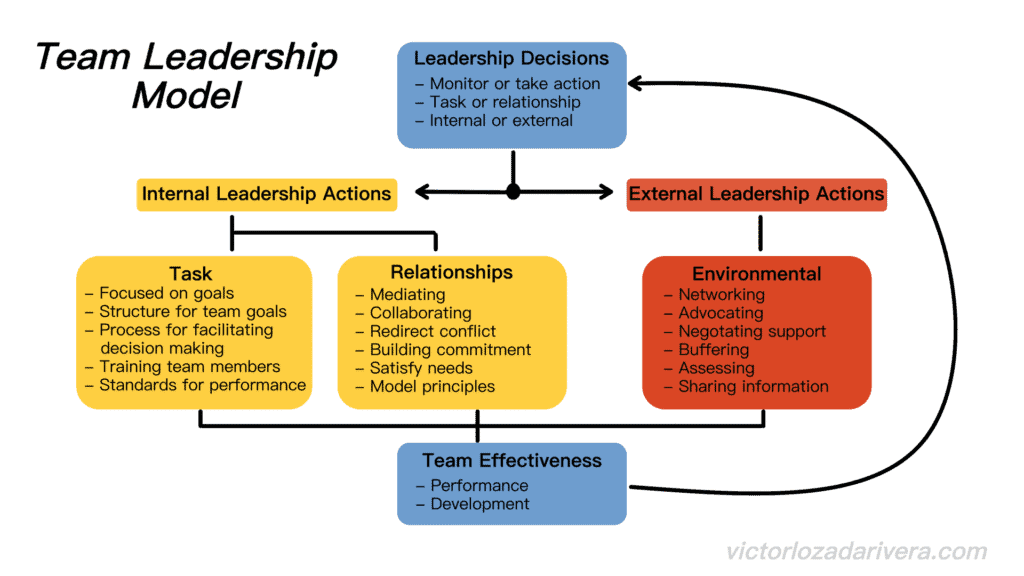The team leadership model shows a way of thinking for leaders who share the team leadership role. It includes ways to resolve team issues by offering many alternative solutions, all the while being aware of the team’s resources, capabilities, and external challenges and opportunities.
The ultimate goal being effective leadership through behavioral flexibility, problem-solving skills, and discretion when determining if leader intervention is necessary.
Take a look a Path-Goal Theory or Gilbert’s Behavior Engineering Model if you interested in other leadership theory.
Overall the model has 4 components:
1. Leadership Decisions
2. Internal Leaderships Actions
a. Related to the task
b. Related to relationships
3. External Leadership Actions
a. Environmental
4. Team Effectiveness

Leadership Decisions
Should I continue to observe, or do I need to take action?
Intervening too soon could diminish the team’s sense of autonomy, however, waiting could cause more damage to team effectiveness. The ability to get it right generally increases as leaders develop more experience in a team setting.
To determine when to intervene, leaders need information. As a leader you need the ability to scan and monitor the internal team dynamics and the external environment in which the team operates. Is the path your team on leading to a breakthrough or breakdown?
I need to take action, is it task or relationship related or both?
Often times issues interventions are needed to clarify the task or roles within the team. However, effective team leadership focuses on both task and relational issues as task productivity with strong team relationships, leads to best team performance and development.
I need to take action, do I need to intervene inside the team or in the external environment?
There are only so many things you can control as a leader. It is important understand the difference between internal and external conflict. Effective team leaders are able to balance the internal and external demands placed on their teams and to know if and when to intervene in one or in both.
Leadership Actions
Once the decision is made to intervene it is important understand which action in relation to what problem is needed to improve team effectiveness.
Internal Task Leadership Actions:
(1) Being focused on appropriate goals
(2) Having the right structure to achieve the team’s goals
(3) Having a process that makes decision making easier
(4) Training team members through development/educational courses
(5) Setting and maintaining appropriate standards for performance
Internal Relational Actions:
(1) Mediating to improve interpersonal skills
(2) Encouraging collaboration among team members
(3) Managing conflict to allow intellectual conflict
(4) Enhancing team commitment
(5) Satisfying the trust and support needs of team members
(6) Being fair and consistent in exercising principled behavior
External Leadership Actions:
(1) Networking to form alliances and gain access to information
(2) Advocating for the team with those who affect its environment
(3) Negotiating with senior management for recognition, support, and resources
(4) Protecting team members from environmental diversions
(5) Examining external performance indicator of effectiveness
(6) Providing team members with appropriate external information
Team Effectiveness
Team effectiveness consists of two overarching dimensions:
• Team Performance to whether and how well team tasks were accomplished
• Team Development refers to how well the team was maintained in accomplishing the team’s tasks
Effective team leaders will find formal and informal ways of examining themselves and their team against these criteria. In general team leaders can ask themselves a few questions to start:
(1) Does the team have SMART goals?
(2) Are team members capable of the task?
(3) Is there unity with respect to commitment to the team’s goals?
(4) Is there a collaborative climate among team members?
(5) Are there standards of success to guide the team?
(6) Is there external support and recognition for the team?
(7) Is team leadership effective?
Conclusion
The team leadership model is meant to help team leaders constantly assess their team’s effectiveness, as well as when and where the team’s leaders need to intervene.
What do you think of the model? Let me know in the comments below.


